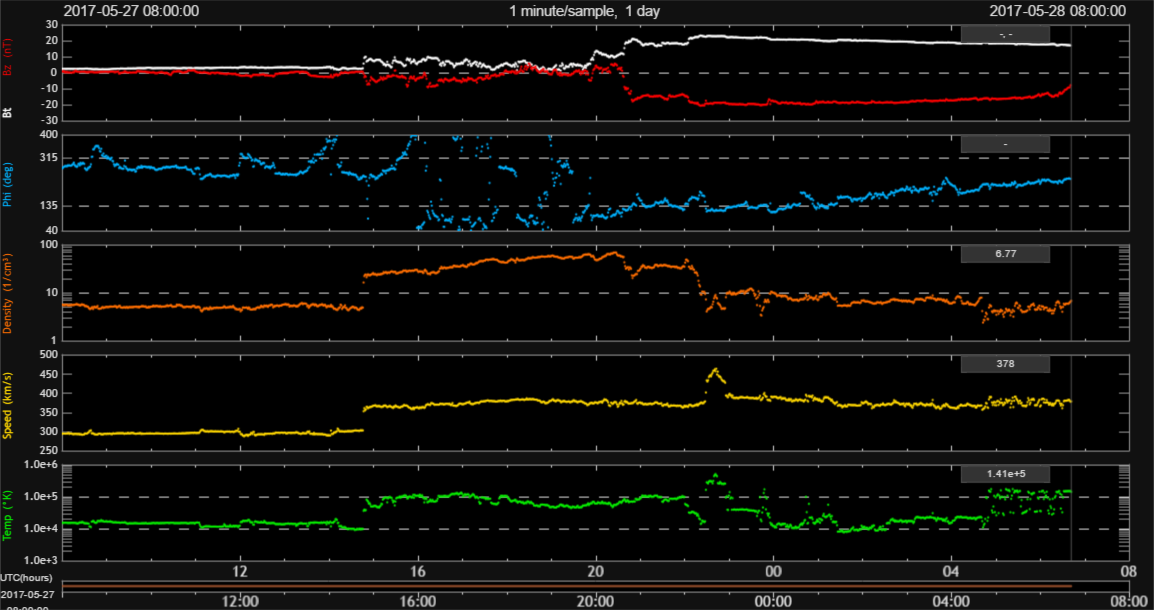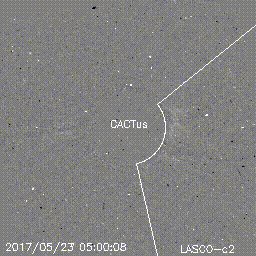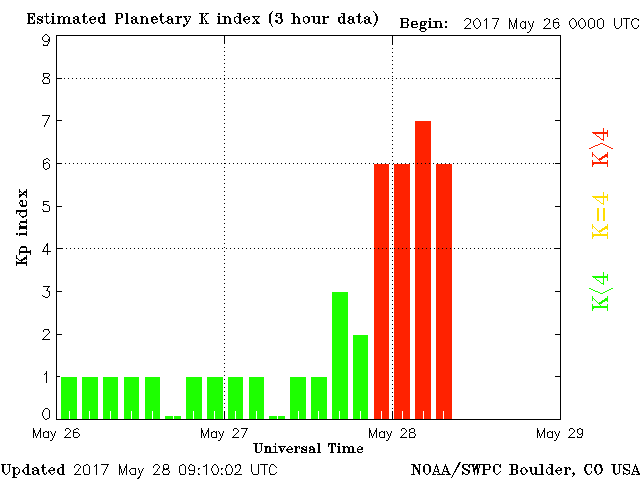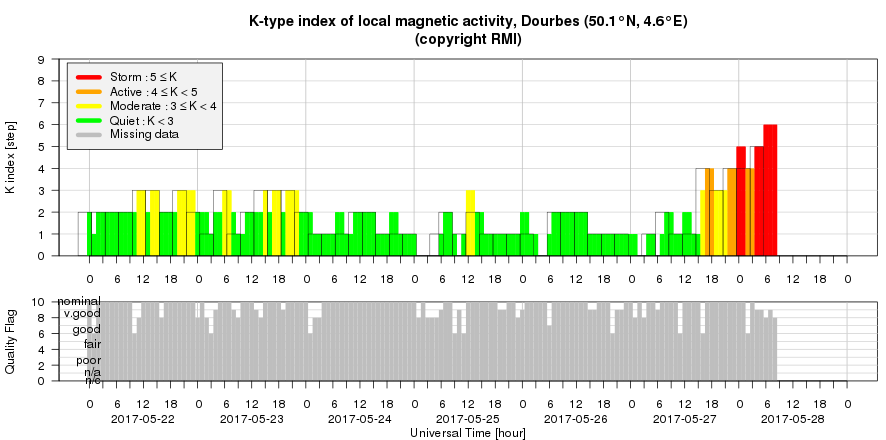NL: Coronale massa ejectie oorzaak van een krachtige geomagnetische storm
FR: Ejection de masse coronale à l'origine d'un orage géomagnétique majeur
EN: A coronal mass ejection as the source of a strong geomagnetic storm
Movies and pictures - Films en foto's - Vidéos et images
Coronale massa ejectie oorzaak van een krachtige geomagnetische storm
Op 27 Mei om 14:48UT registreerde de DSCOVR satelliet een kleine schok in de zonnewind parameters. Deze schok was een gevolg van de aankomst van een interplanetaire coronale massa ejectie (ICME) die de Zon had verlaten tijdens de ochtend van 23 Mei, volgend op een eruptieve gebeurtenis nabij het centrum van de zonneschijf enkele uren daarvoor. Na een initieel kleine verstoring in de zonnewind kwam de kern van de ICME aan rond 21:00UT. Het magnetische veld was sterk en draaide zuidwaarts, waarbij het gedurende meerdere uren een waarde van ongeveer -20 nT aanhield.
Dit waren ideale omstandigheden voor een sterke geomagnetische storm. Een Kp=7 (sterke storm) werd geobserveerd tussen 3:00 and 6:00UT op 28 Mei, en in Dourbes (België) werden episodes van een matige storm (K=6) gerapporteerd vanaf 6:00UT. Tot dusver werd enkel poollicht waargenomen langs de Amerikaans-Canadese grens, maar meer waarnemingsverslagen worden verwacht. Poollicht was niet zichtbaar vanuit België. Geen andere effecten werden gerapporteerd tot dusver, hoewel de storm sterk genoeg was (Dst rond -122 nT) om enige impact te hebben op elektriciteitsnetwerken, (Scandinavië,...), satelliet operaties, en HF radio communicatie.
The storm lijkt nu geleidelijk in kracht af te nemen, maar is nog niet voorbij. Zijn effecten kunnen de omgeving van de Aarde zeker nog de rest van de dag beïnvloeden. Er worden nog steeds periodes met geomagnetische storm verwacht, evenwel zonder gevolgen voor België (geen poollicht). Updates (in het Engels) zijn beschikbaar op de website van het SIDC.
Ejection de masse coronale à l'origine d'un orage géomagnétique majeur
Le 27 Mai à 14:48UT, le satellite DSCOVR a observé un choc dans le vent solaire. La source de ce choc était une éjection de masse coronale interplanétaire (ICME) qui avait quitté le Soleil le 23 Mai, à la suite d'une éruption près du centre du disque solaire. Initiallement, la perturbation était minimale, mais vers 21:00UT, le noyau de l'ICME arrivait. Son champ magnétique était fort (-20 nT) et orienté vers le sud pendant des heures.
Ainsi, un orage géomagnétique majeur (Kp=7) a été observé entre 3:00 and 6:00UT le 28 Mai. A Dourbes (la Belgique), des orages modérés (K=6) ont été observés. Les aurores boréales n'étaient pas visibles de la Belgique, des observations proviennent surtout de la frontière entre les Etats-Unis et le Canada. Jusqu'a présent, pas d'autres effets ont été rapportés, bien que l'orage soit assez fort (Dst vers -122 nT) pour avoir une influence sur les réseaux électriques (la Scandinavie,...), les opérations de satellite, et les communications radio HF.
L'orage géomagnétique semble diminuer en force, mais n'est pas encore terminé. Il est attendu que le vent solaire associé influencera l'environnement de la Terre pour au moins le restant de la journée (28 Mai). Encore plus d'épisodes d'orage majeur sont attendus, néanmoins sans conséquences pour la Belgique (pas d'aurores boréales). Les mises-à-jour seront disponibles (en Anglais) sur le site web du SIDC.
A coronal mass ejection as the source of a strong geomagnetic storm
On 27 May at 14:48UT, the DSCOVR satellite registered a small shock in the solar wind parameters. This shock was related to the arrival of an interplanetary coronal mass ejection (ICME) that left the Sun early on 23 May following an eruptive event near the centre of the solar disk. Initially a mild disturbance, the core of the ICME arrived around 21UT with its strong magnetic field becoming persistently southward (around -20 nT).
These were ideal conditions for a strong geomagnetic storm. Globally, Kp=7 were observed (strong storm) between 3:00 and 6:00UT on 28 May, whereas in Dourbes (Belgium) moderate storming episodes (K=6) were reported starting at 6:00UT. So far, polar lights have been observed near the American-Canadian border, but reports are still coming in. Polar lights were not visible from Belgium. No other effects have been reported so far, though the storm was strong enough (Dst around -122 nT) to have had an effect on power networks (Scandinavia,...), spacecraft operations and HF radio communications.
The storm seems to gradually subside, but is not over yet. The solar wind stream is expected to continue influencing the earth-environment for at least the remainder of the day. Further geomagnetic storming episodes are expected, however without any consequences for Belgium (no polar lights). Updates (in English) are available at the website of the SIDC.
Movies,... - Films,... - Vidéos,...
An image of the solar wind data by DSCOVR , a movie from the CME by LASCO/C2 (CACTus), and geomagnetic recordings.
Een beeld van de zonnewinddata door DSCOVR , een filmpje van de CME door LASCO/C2 (CACTus), en geomagnetische waarnemingen.
Une image des paramètres du vent solaire enregistrés par DSCOVR , un vidéo de la CME par LASCO/C2 (CACTus), et quelques observations géomagnétiques.




 |
 |





